Patterns and textures are fundamental components of interior design. They serve as the visual and tactile soul of a space, infusing it with depth, warmth, contrast, and personality. Each pattern, whether it’s geometric, floral, or abstract, and every texture, be it smooth, rough, soft, or hard, brings with it an unspoken narrative that has the power to transform an ordinary room into an artistic canvas of style and expression.
In the context of interior design, patterns are defined as repetitive designs or motifs that are used to add visual interest and character to a space. They appear in numerous forms including wallpaper prints, fabric designs, tile arrangements, and even in the arrangement of furniture. They can direct the eye, unify a design, and even create an illusion of movement. Textures refer to the surface quality of an object that can be perceived either by touch (tactile texture) or visually (visual texture). They add depth and dimension to a room, contribute to its comfort and warmth, and can balance the visual weight of different elements. Textures can greatly influence how a space feels – for example, a room with a lot of hard, smooth surfaces will feel different from one filled with soft, plush fabrics. This article guides you through the basic principles of mixing patterns and textures, starting with the different types and uses of each, and then providing practical tips to ease you into this creative hobby.
Table of Contents
Basic Principles of Mixing Patterns and Textures
1. Balance and Contrast
While uniformity can result in a space feeling flat and uninteresting, too much variety can create a sense of chaos. The secret of how to decorate your home lies in creating a contrast that strikes a delicate balance – bold patterns paired with subtle ones, or smooth textures offset by rough ones, can create visually captivating spaces.
2. Scale and Proportion
A mix of larger patterns with smaller ones prevents them from competing for attention. Large, chunky textures may overwhelm a small room, while fine textures may go unnoticed in a large room.
3. Color Coordination
The colors within your chosen patterns and textures should ideally align with your overall color scheme. Coordinating colors help unify a space, while contrasting colors can add a spark of interest. Using a consistent color palette can allow more freedom in mixing diverse patterns and textures.
4. Pattern and Texture Hierarchy
Not all patterns and textures in a room should have the same level of prominence. Establish a hierarchy. Choose one pattern or texture to serve as the dominant feature, and others to act as subordinate or accent elements. This ensures that each piece contributes to the overall design without overwhelming it.
Patterns in Interior Design
1. Geometric Patterns
Geometric patterns, with their clean lines and shapes, can introduce a sense of order and modernity. They are often used in contemporary design settings, but they also work well in traditional spaces when used subtly.
2. Floral Patterns
Floral patterns, encompassing everything from stylized to realistic representations of nature, evoke a feeling of romance and softness. They are often used to add a touch of elegance and charm, and can create a casual, country feel or a formal, traditional look depending on the style and coloration.
3. Abstract Patterns
Abstract patterns offer a unique blend of creativity and freedom, perfect for creating a bold, artistic statement. They can add a sense of movement and energy to a room, making it feel more dynamic.
4. Stripes, Plaid, and Paisley
Stripes can create an illusion of height or width, plaids add a cozy, rustic feel, while paisley can lend a bohemian or traditional touch.
Textures in Interior Design
1. Hard vs. Soft Textures
Hard textures, such as metal, wood, and glass, add an edge of sleekness and modernity. They reflect more light, making a room feel brighter. Conversely, soft textures, like rugs, pillows, and upholstery, contribute to a cozy, inviting feel, absorbing light and noise to create a soothing ambiance.
2. Shiny vs. Matte Textures
Shiny textures reflect light, creating a sense of sparkle and luxury, but can also visually enlarge a space. Matte textures absorb light, giving a more understated, sophisticated appeal, and can add depth and warmth to a room.
3. Smooth vs. Rough Textures
Smooth textures, such as polished stone or silk, contribute to a clean, modern look, while rough textures, like burlap or raw wood, add an organic, rustic feel. The contrast between smooth and rough can create a rich sensory experience, offering visual interest and depth.
Tips for Mixing Patterns and Textures
Layering Different Textures
Layering various textures can make a space feel more complex and inviting. It’s about pairing complementary textures — think plush rugs on hardwood floors or silky cushions on a rough fabric sofa.
Creating Harmony
Repeating patterns or textures throughout a space can create a sense of harmony and cohesion. It’s not about using the same pattern everywhere, but subtly echoing it — perhaps the geometric pattern on your rug is mirrored in your throw pillows.
Incorporating Natural Textures
Natural textures, like wood, stone, or woven fibers, can bring an organic, grounding feel to a space. They add a touch of the natural world into the interior design, contributing to a peaceful, relaxing ambiance.
The art of mixing patterns and textures in interior design is a potent tool in creating spaces that are not only visually captivating but also imbued with depth, warmth, and personality. By understanding these fundamental elements and mastering the techniques to harmonize them, you can transform any space into a visually engaging and tactilely rich environment. The beauty of design lies in experimentation, so don’t be afraid to explore and let your creativity shine in your own unique design journey.







